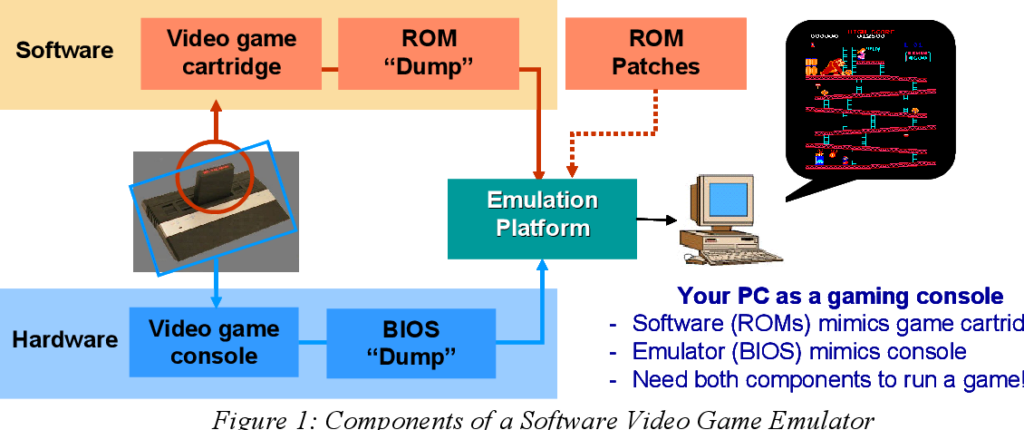Nostalgia and growing up with video games
Growing up playing video games creates such nostalgia for the systems played. Unfortunately, over time the consoles stop working, and life changes such as moves away from home may mean that you leave those older systems behind. What do you do if you want to check out the older games you loved as a child? There are a few avenues, some games are constantly re-released, though a majority of titles (over 85% according to the Video Game History Foundation) are not. This is where Emulation comes into play.
What is game emulation… or emulation in general
At its core, video game emulation is essentially a computer program pretending to be a video game console or computer. More specifically, an emulator is a piece of software behaving exactly the way (at least as much as possible) pretending to be the processor, memory, graphics unit, etc. so when a ROM file for a game is read – the output on screen and behaves as closely to the original hardware as possible. Some consoles have proprietary software that must be running to play a game on an emulator called a BIOS file or firmware file that can either be replicated from the original hardware, or found with a quick Google search.

Is Emulation Legal?
Strictly speaking, Emulators are not illegal – nor are backing up your owned video games to files or playing them on your computer. There’s presently (at the time of this writing) no legal precedent I can find that shows the illegality of this. The problem comes from downloading ROMs of games you do not own and distributing ROMs due to copyright violations. The struggle with the lack of laws governing emulation, questionable copyright pieces, and no legal avenue to purchase games makes the topic challenging, to say the least. Video game preservationists feel strongly that the code should not be lost as the physical media games were stored on (i.e. cartridges for the Nintendo, Atari, etc.) and there should be legal support to showcase the history and sharing of games that are not being sold today. Companies who own intellectual property do not want to lose the potential to make money in the future by potentially reselling games from 30 years ago or more if they decide to do so. As of this writing it’s a bizarre stalemate in that downloading ROMs is rampant, and companies (outside of Nintendo) don’t really want to go to the expense of prosecuting or going after people for playing games that the company won’t sell anyway.
Emulator Adjacent Technology
There are other technologies that enable games to be played not on the hardware or platform initially intended but are not strictly speaking emulators.
WINE and Proton
Wine – or Wine Is Not an Emulator – is a collection of Windows-type software libraries that are free and open source that allow Windows-based games to run on a platform like Linux when it’s designed to run on Windows. Gaming on Linux has never been great, and the intention of WINE is to increase cross-compatible support between Linux and Windows platforms. Wine was/is somewhat popular but relatively difficult to use, and consistently had quite a few bugs on common games and never gained the level of mainstream popularity it shot for.
Proton is a compatibility layer similar to WINE but has Valve as a company backing it and owning the compatibility. Since Valve owns the Steam game platform, they have a significant interest in allowing their games to be played on any platform and are largely successful. While Proton certainly isn’t perfect and still creates some issues in games that don’t exist on Windows, it’s largely regarded as better than Wine and is actively being updated.
FPGA
FPGA or Field Programmable Gate Arrays started as a versatile platform for testing potential hardware configurations for prototyping via software and specific processor architecture. Unlike software emulators which run on an x86/x64 computer, FPGA boards are designed to masquerade as physical hardware in a way that dramatically improves the ability to accurately play older games. Companies like Analogue have sold hardware platforms such as the Super NT which can accurately play Super Nintendo game cartridges – or ROMs via an SD card port with the jailbreak code released. There’s an open-source project called the MiSTER which takes common FPGA boards and enables play via ROMs with the Nintendo, Atari, and Super Nintendo up to the PS1. FPGAs are almost like a marriage between true hardware and software emulation and are pretty fascinating.
Future of Emulation..?
Personally, I feel the future of Emulation is FPGA-based answers, though I’m not certain if the power gap that exists will be bridged. A significant update is needed at the time of this writing to go beyond the PS1 in terms of architecture and being able to power newer systems. Will that update happen or will something else come along that trumps FPGA? Who knows, I certainly didn’t see FPGA coming, but the future should be interesting as it unfolds!